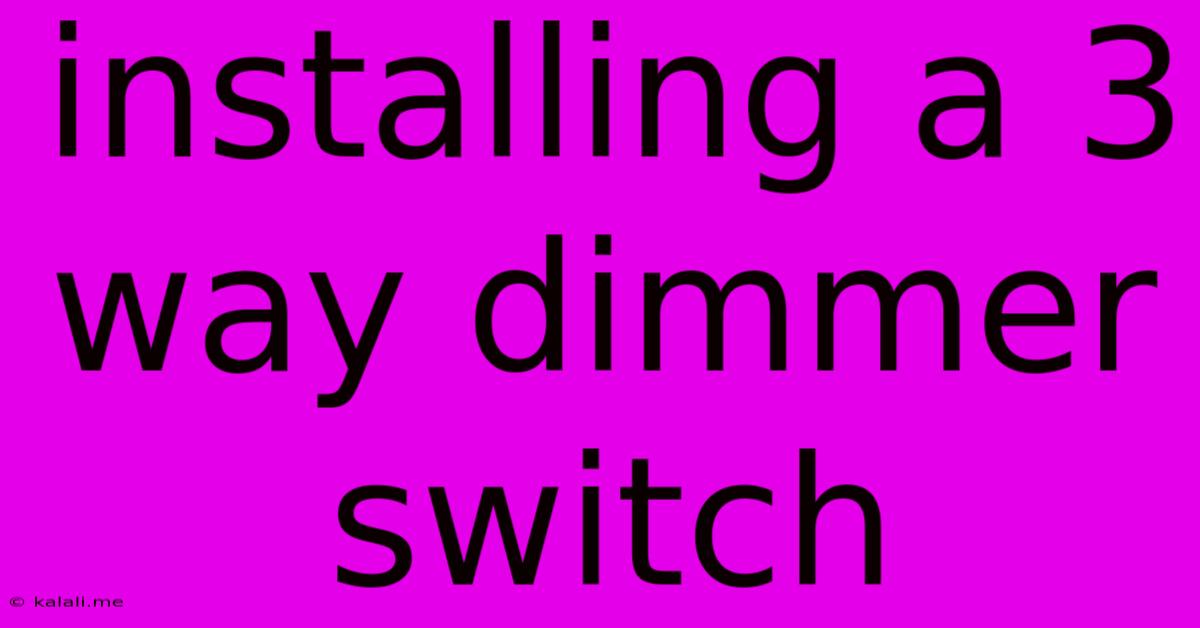Installing A 3 Way Dimmer Switch
Kalali
Jun 10, 2025 · 3 min read

Table of Contents
Installing a 3-Way Dimmer Switch: A Step-by-Step Guide
Meta Description: Learn how to install a 3-way dimmer switch safely and effectively. This comprehensive guide provides step-by-step instructions, safety precautions, and troubleshooting tips for a successful installation. Perfect for DIY homeowners looking to upgrade their lighting.
Installing a 3-way dimmer switch might seem daunting, but with careful planning and a methodical approach, it's a manageable DIY project. This guide will walk you through the entire process, from gathering the necessary tools and materials to troubleshooting potential problems. Remember, safety is paramount, so always turn off the power at the breaker box before starting any electrical work.
What You'll Need:
- 3-Way Dimmer Switch: Make sure to purchase a dimmer switch specifically designed for 3-way circuits. These switches have three terminals instead of the usual two. Check the amperage rating to ensure it matches your circuit's requirements.
- Neutral Wire: If your existing switch box doesn't have a neutral wire, you'll need to locate one and run it to the switch box. This is crucial for most modern dimmer switches. A qualified electrician might be required for this step.
- Screwdrivers: Phillips and flathead screwdrivers of various sizes.
- Wire Strippers/Cutters: For neatly stripping the insulation from the wires.
- Voltage Tester: Essential for verifying the power is off and for troubleshooting.
- Wire Connectors (Wire Nuts): To securely connect the wires.
- Electrical Tape: For added insulation around the wire connections.
- Optional: Non-metallic fish tape or similar tool: Helpful for fishing wires through walls if necessary.
Step-by-Step Installation:
1. Turn Off the Power: This is the most critical step. Locate the breaker controlling the lighting circuit and switch it to the "OFF" position. Double-check with a voltage tester to ensure the power is off.
2. Remove the Existing Switches: Carefully remove the faceplates of both 3-way switches. Use a screwdriver to loosen and remove the screws holding the switches in place. Gently pull the switches out of the boxes.
3. Identify the Wires: Common 3-way wiring uses three wires: two travelers (usually black or red), a common (usually black or red), and a neutral (white). There might also be a ground wire (bare copper or green). Take photos before disconnecting any wires to help with reassembly.
4. Connect the New Dimmer Switch: This is where understanding 3-way wiring is key. The dimmer switch will typically have three terminals: two for the traveler wires and one for the common. Carefully connect the wires from the old switch to the corresponding terminals on the new dimmer switch. The neutral wire (if available) will connect directly to the neutral wire terminal of the dimmer switch. The ground wire should connect to the ground screw on the switch box.
5. Secure the Wires: Use wire connectors to make secure connections. Ensure each wire is properly twisted and tightened. Wrap electrical tape around each connection for additional insulation.
6. Mount the Switch: Carefully tuck the wires into the switch box and mount the new dimmer switch securely to the box using the screws provided.
7. Test the Installation: Turn the power back on at the breaker box. Test the switch functionality by turning the lights on and off from both locations.
8. Install Faceplates: Once everything is functioning correctly, install the faceplates on the switches.
Troubleshooting:
- Lights Don't Turn On: Check the breaker, wiring connections, and the dimmer switch itself.
- Dimming Doesn't Work: Ensure you have the correct type of dimmer switch for your light bulbs (e.g., incandescent, LED, CFL). Incandescent bulbs are compatible with most dimmer switches but LEDs and CFLs need dimmable versions.
- One Switch Controls the Lights, the Other Doesn't: This usually indicates incorrect wiring of the traveler wires. Double-check your connections and refer to the wiring diagrams included with your dimmer switch.
This guide provides a general overview. If you are uncomfortable working with electricity, it's best to consult a qualified electrician. Always prioritize safety and double-check your work before turning the power back on.
Latest Posts
Latest Posts
-
Do You Put Your Writing Sample In Italics
Jun 10, 2025
-
Can You Pour Concrete Over Gravel
Jun 10, 2025
-
Terraria How To Fish In Lava
Jun 10, 2025
-
How To Pull A Fuse In A Car
Jun 10, 2025
-
Led Landscape Lighting Only First Light Is Turning On
Jun 10, 2025
Related Post
Thank you for visiting our website which covers about Installing A 3 Way Dimmer Switch . We hope the information provided has been useful to you. Feel free to contact us if you have any questions or need further assistance. See you next time and don't miss to bookmark.